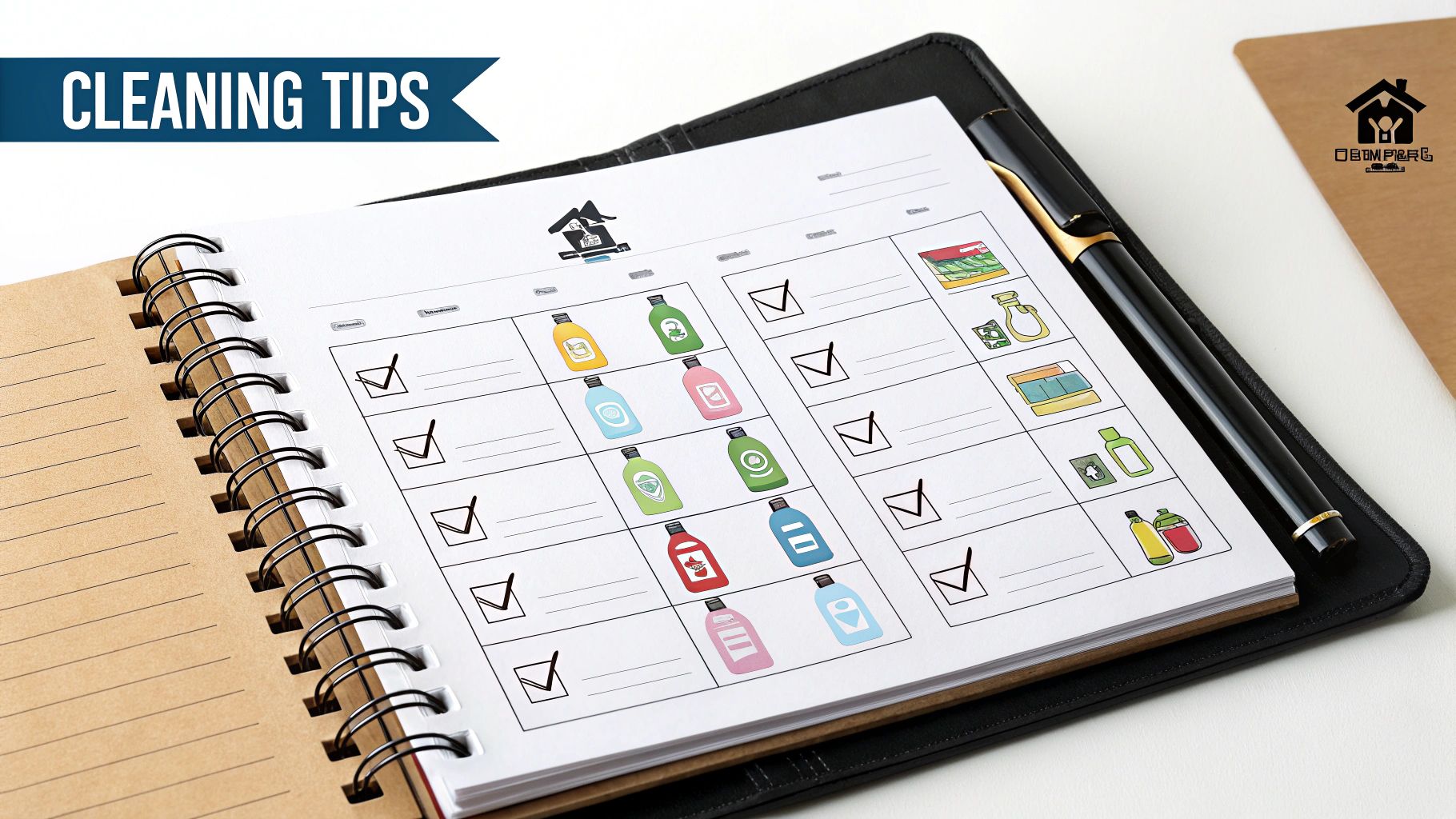Getting found online by local customers can be a major challenge for any cleaning company. You've likely heard of Search Engine Optimization (SEO), but turning that concept into actual clients can feel complex. This guide simplifies it. We’ll break down the best strategies for SEO for cleaning business into a clear, step-by-step roadmap you can use today.
Forget confusing jargon. We are focusing on practical tactics to help you show up in local search results and get more calls. These are the methods successful cleaning services use to fill their schedules. For a deeper dive into the core concepts, you can learn more about what Search Engine Optimization truly is, but this article gives you a specific playbook for your industry.
In Short: This guide provides a clear plan to improve your online visibility, attract more qualified leads, and grow your cleaning business with SEO.
In this listicle, we’ll walk through exactly how to:
- Optimize your Google Business Profile to appear in the local map pack.
- Create service-specific landing pages that convert visitors into leads.
- Build a five-star reputation through effective review management.
- Develop content that answers customer questions and establishes your expertise.
- Secure powerful local citations that boost your authority.
- Ensure your website is fast and mobile-friendly for users on the go.
By the end, you will have a solid plan to attract a steady stream of new customers. Let's get started.
1. Local SEO Optimization and Google Business Profile
If you do one thing, get this right. Local SEO is what brings neighborhood customers to you. When someone needs their home cleaned, they search for things like “house cleaning in Austin” or “maid service near me.” Your goal is to be the first name they see. This is the foundation of effective SEO for a cleaning business.
Local SEO means optimizing your online presence to attract customers from local searches. The most important tool for this is your Google Business Profile (GBP). This free profile is your digital storefront on Google Search and Maps. It's often a customer's first impression of you.
How do I get my cleaning business on Google?
Getting your business on Google starts with your Google Business Profile.
- Create or Claim Your Profile: Go to google.com/business to claim or create your listing.
- Verify Your Business: Google will mail a postcard with a verification code to your physical address to confirm it's a real business.
- Complete All Sections: Fill out every field: services, service areas, hours, photos, and a detailed business description. The more info you provide, the better.
The Power of a Perfected Google Business Profile
Look at a major cleaning franchise like MaidPro. When you search for "maid service" where they operate, their local branch often appears in the "Map Pack" at the top of the results.
Their secret is consistency and active management.
- Complete & Accurate Profiles: Every location has a full GBP with correct hours, address, phone number, and website link.
- Active Engagement: They regularly upload photos, publish posts about special offers, and respond to all customer reviews.
- Service & Area Details: They clearly list all services (e.g., "deep cleaning," "recurring maid service") and define their service areas. This tells Google who to show their profile to.
Key Takeaway: Treat your Google Business Profile like a social media feed. Keep it updated with fresh, relevant information to build trust with Google and customers.
This workflow shows that a strong Google Business Profile is the starting point. Next comes building consistent business listings online and managing your reputation.
Actionable Tips to Dominate Local Search
Here’s a checklist to get you started:
- Claim and Verify Your GBP: Go to google.com/business and claim your profile. Wait for the verification postcard.
- Fill Out EVERYTHING: Don't skip fields. Add services, service areas, hours, photos, and your business description. The more information, the better.
- Use Google Posts Weekly: Post updates at least once a week. Share before-and-after photos or announce a special. This shows Google you're active.
- Get Your NAP Consistent: Your Name, Address, and Phone number must be identical everywhere, from Yelp to Facebook. Inconsistencies hurt your ranking. To learn more, explore guides on house cleaning SEO from ClicksGeek.com.
For a deeper dive into optimizing your profile, this video offers some excellent visual tips:
2. Service-Specific Landing Pages
Your homepage gives a general overview. But many customers search for a specific solution. Someone needing a deep clean has different needs than a landlord needing a move-out clean. Creating dedicated landing pages for each service is a powerful way to capture these customers. This is a core part of effective SEO for a cleaning business.

The idea is simple: one page, one service, one goal. A page for "post-construction cleanup in Denver" can be hyper-focused on that service. This detail tells Google you're an expert and gives users a better experience, leading to higher rankings.
The Power of Hyper-Focused Service Pages
Molly Maid is a master of this technique. They have separate, information-rich pages for "Apartment Cleaning," "Move-Out Cleaning," and "Special Event Cleaning."
What makes their approach effective is relevance and authority.
- Targeted Content: Each page is a deep dive. The move-out cleaning page discusses checklists and landlord requirements. This answers the searcher's questions.
- Keyword Optimization: The "Apartment Cleaning" page is optimized for terms like "apartment cleaning services." They often add local terms to attract nearby customers.
- Clear Call-to-Action (CTA): Every service page has a clear CTA, like "Request a Free Estimate," guiding the user to the next step.
Key Takeaway: Don't make one page do the work of ten. Create individual pages for each service to match a customer's specific search query.
Actionable Tips for Creating Killer Service Pages
Ready to build landing pages that work? Here’s a checklist:
- One Page Per Service: List every service you offer: residential, commercial, deep cleaning, move-in/out, etc. Each one gets its own page.
- Optimize for Service + Location Keywords: The page title and H1 heading should include the service and your city (e.g., "Professional Move-Out Cleaning Services in Portland").
- Include Service-Specific Testimonials: A review about your deep cleaning is more powerful on your "Deep Cleaning" page than on your homepage.
- Use High-Quality Before-and-After Photos: Show your work. For a "Post-Construction Cleaning" page, display photos of a dusty site made pristine.
- Build an FAQ Section: Answer common questions for each service. For "Airbnb Cleaning," you might answer, "Do you handle laundry?" This builds confidence. For help finding questions, see this guide on keyword research from Sure-Fire SEO.
3. Review Management and Schema Markup
If local SEO is the engine, reviews are the fuel. Trust is everything online, especially for a personal service like cleaning. Review management is about building a public reputation that convinces customers to choose you. This is a critical part of a winning strategy for SEO for a cleaning business.
This process has two parts. First, you manage your reputation by encouraging and responding to feedback. Second, you use a tool called Schema Markup to show your star rating directly in Google search results. This makes your listing much more clickable.
How do I get more reviews for my cleaning business?
Getting more reviews requires a system.
- Ask for Them: The best way to get reviews is to ask happy customers.
- Time it Right: Send a request via email or text 24-48 hours after the cleaning service, when the experience is fresh.
- Make it Easy: Provide a direct link to your Google Business Profile review section to reduce friction.
The Power of Showcasing Social Proof
Platforms like Handy or TaskRabbit have mastered integrating reviews. When you search for their services, you see a rating.
Their secret is making reviews a seamless part of the experience.
- Integrated Review Systems: They prompt users for feedback right after a service. This constant flow of fresh reviews signals relevance to Google.
- Visible Ratings: They use review schema markup so their star ratings appear in search results. This "rich snippet" increases clicks.
- Leveraging Feedback: They use review data to improve their services. Negative feedback is data to help them get better.
Key Takeaway: Don't just hope for reviews. Build a system to generate and showcase them. This turns customer satisfaction into a powerful marketing asset.
Actionable Tips to Master Your Reputation
Here’s a checklist to build and showcase your online reputation:
- Ask at the Right Time: Send a review request within 24-48 hours of service.
- Make It Easy: Provide a direct link to your Google Business Profile review section.
- Respond to EVERY Review: Thank customers for positive reviews. For negative ones, respond professionally and offer to resolve the issue offline.
- Implement Review Schema: Use a plugin or developer to add
LocalBusinessandAggregateRatingschema to your site. This code tells Google to show your star rating. Test it with Google's Rich Results Test. - Showcase Reviews on Your Site: Use a widget to embed your latest reviews directly on your homepage.
4. Content Marketing with Cleaning Tips and Guides
How do you attract customers who aren't ready to book yet? The answer is content marketing. This strategy makes your business a trusted expert by providing helpful information. When someone searches "how to get red wine out of a carpet," you want your website to have the answer. This is a subtle but powerful part of SEO for a cleaning business.

Content marketing for a cleaning company means creating blog posts and guides that solve customer problems. You're not just selling a service; you're selling expertise. This approach builds a relationship long before they need to hire you. It’s an effective strategy for any business, including those looking at content marketing for startups.
The Power of Authoritative Content
The Maids, a national service, has a blog that is a masterclass in this. They don't just write about their services; they tackle specific cleaning questions.
Their secret is thinking like a customer.
- Problem-Solving Content: Their blog has guides like "How to Deep Clean a Kitchen." These articles rank for search terms that thousands of people use.
- Seasonal Relevance: They use seasonal trends with content like "Your Ultimate Spring Cleaning Checklist."
- Clear Calls-to-Action: The articles subtly guide readers toward a professional solution, often ending with a CTA to call the experts.
Key Takeaway: Stop thinking like a salesperson. Start thinking like a helpful expert. Answer the questions your customers are asking Google.
This strategy helps you engage a broader audience. For more ideas, especially for B2B, explore marketing for commercial cleaning businesses at ClicksGeek.com.
Actionable Tips to Become a Content Authority
Here’s a checklist to create content that attracts customers:
- Solve Real Problems: Use Google's "People Also Ask" feature to find what questions customers have. Provide clear, step-by-step solutions.
- Embrace Seasonal Content: Create checklists for specific times of the year, like a "Holiday Pre-Guest Cleaning Guide."
- Show, Don't Just Tell: Use before-and-after photos and short videos in your blog posts.
- Optimize for Featured Snippets: Structure answers with headings and bullet points. This increases your chances of being featured in Google's "answer box."
- Repurpose Everything: Turn a blog post into social media graphics, an email newsletter, or a short video.
5. Local Citation Building and Directory Optimization
If your Google Business Profile is your storefront, local citations are the signposts pointing to it. A citation is any online mention of your business's Name, Address, and Phone number (NAP). The more consistent these signposts are, the more Google trusts that your business is legitimate. This is a crucial part of a complete strategy for SEO for a cleaning business.
Local citation building means getting your business listed on relevant online directories like Yelp, Angi, and local chamber of commerce pages. Each consistent listing is a vote of confidence. When Google sees the same NAP for your business across dozens of sites, it helps you rank higher in the local map pack.
The Power of Consistent Directory Presence
ServiceMaster Restore, a major restoration and cleaning franchise, excels at citation strategy.
Their success comes from a systematic approach.
- Widespread & Consistent Listings: Each franchise is listed on dozens of high-authority directories with identical NAP information.
- Corporate & Local Synergy: The corporate office often creates foundational citations. Local owners then add listings in hyper-local directories.
- Rich Profile Content: Their directory profiles are full of service descriptions, photos, and links back to their local webpage.
Key Takeaway: Citation building is about quality and consistency. A messy NAP sends confusing signals to Google, while clean data builds a powerful foundation for local rankings.
Actionable Tips to Build Your Citations
Ready to build your network of digital signposts? Here’s a checklist:
- Start with the Big Four: Ensure your profiles on Google Business Profile, Yelp, Facebook, and Bing Places are perfect.
- Master NAP Consistency: Your Name, Address, and Phone number must be exactly the same everywhere. "Suite 101" and "Ste. #101" are not the same to a search engine.
- Focus on Relevance: Prioritize quality over quantity. Get listed on home service sites like Angi and HomeAdvisor, then local directories.
- Use a Management Tool: Services like BrightLocal or Moz Local can help you find opportunities and fix inconsistencies. This is central to effective local SEO for any business.
- Enrich Your Profiles: Add business hours, a compelling description, photos, and a website link to make every listing a powerful asset.
6. Mobile Optimization and Site Speed Enhancement
Imagine a customer searching on their phone for "last-minute cleaning service." If your website is slow or hard to use, they'll leave. This happens every day, which is why mobile optimization and site speed are essential for SEO for a cleaning business. Most local searches happen on mobile, and Google penalizes sites with a poor mobile experience.

This is about making your website easy for everyone to use. Your site must adapt to any screen size (responsive design), load in under three seconds, and make it simple to call or book.
What is the best SEO for a cleaning company?
The best SEO for a cleaning company is a local, mobile-first strategy. This means prioritizing your Google Business Profile, building local citations, and ensuring your website is fast and easy to use on a smartphone. Because most customers are searching for services "near me" on their phones, a seamless mobile experience is critical for converting them into clients.
The Power of a Mobile-First Experience
Handy, a major home services platform, built its entire experience around mobile users.
Their secret is prioritizing the mobile journey.
- Seamless Booking Flow: Handy's mobile site has a simple, step-by-step booking process. Users can get a quote in just a few taps.
- Lightning-Fast Performance: Their pages load almost instantly. They optimize images and keep the design clean.
- Clear Calls-to-Action: Large, easy-to-tap buttons like "Get a Price" are always visible.
Key Takeaway: Don't just make your website work on mobile; design it for mobile. Users on the go want speed, simplicity, and easy access to contact info.
Actionable Tips to Speed Up Your Site
Here’s a checklist to make your website faster and more mobile-friendly:
- Test Your Performance: Use Google's PageSpeed Insights and Mobile-Friendly Test tools. They give you a score and a list of issues to fix.
- Optimize Your Images: This is a common cause of slow sites. Before uploading, compress photos using a tool like TinyPNG.
- Enable Lazy Loading: This tells a browser not to load images until a user scrolls to them. It improves initial page load time.
- Simplify Your Navigation: On mobile, use a clear "hamburger" menu. Make your phone number a "click-to-call" link at the top of the page.
SEO Strategy Comparison for Cleaning Businesses
| Strategy | Implementation Complexity 🔄 | Resource Requirements 💡 | Expected Outcomes 📊 | Ideal Use Cases 💡 | Key Advantages ⭐ |
|---|---|---|---|---|---|
| Local SEO & GBP | Medium | Moderate | High local visibility, customer engagement | Businesses targeting nearby customers | Cost-effective, dominates local search |
| Service Landing Pages | High | High | Improved conversions, long-tail keyword capture | Targeting detailed service queries | Targets specific search intents, builds confidence |
| Review Management & Schema | Medium-High | Moderate | Increased click-through rates, higher rankings | Businesses focusing on reputation | Enhances search snippets, builds trust |
| Content Marketing | High | High | Establishes authority, builds organic traffic | Brand awareness, capturing informational searches | Builds trust, long-tail keyword capture |
| Local Citation Building | Medium | Moderate | Improved local rankings & visibility | Enhancing local search presence | Increases authority, multiple lead sources |
| Mobile & Speed Optimization | High | High | Better user experience, improved mobile rankings | Businesses with mobile search traffic | Increases conversions, prioritized by Google |
Your Next Steps for Dominating Local Search
We've covered a lot. From your Google Business Profile to helpful content, SEO for cleaning business can feel like a big job. But you don’t have to do it all at once. Think of it like cleaning a large property: tackle one room at a time.
The most successful cleaning companies got there through consistency. They started with the basics and gradually added more. Your journey can be the same.
Recapping Your SEO Blueprint
Here are the core pillars for attracting a steady stream of local cleaning jobs.
- Google Business Profile (GBP) is #1: It's your digital billboard. An optimized profile with great photos and posts is the fastest way to get in front of customers.
- Targeted Landing Pages Convert: Create dedicated pages for "office cleaning in [Your City]" or "post-construction cleanup." This shows Google you're an expert.
- Reviews are Social Proof: A steady stream of positive reviews is a powerful trust signal. Set up a simple system to ask every happy customer for one.
- Content Marketing Builds Authority: Blog posts like "The Ultimate Spring Cleaning Checklist" establish you as the local expert.
- Citations and Mobile Speed are Foundational: Consistent NAP information builds your location authority. A fast, mobile-friendly website ensures users don't leave.
Your Actionable Roadmap: What to Do Next
Feeling overwhelmed? Don't be. Here is a simple plan to start this week.
- The GBP Audit (Tomorrow): Log into your Google Business Profile. Are all fields filled out? Have you uploaded at least 10 high-quality photos?
- Pick ONE Service Page (This Week): Choose your most profitable service. Build a dedicated landing page for it with keywords, testimonials, and a clear CTA.
- Set Up Your Review Funnel (This Weekend): Choose a method to start asking for reviews. Create a direct link to your GBP review form.
By focusing on these three steps, you'll build momentum. Mastering the fundamentals of SEO for cleaning business is what separates surviving companies from thriving ones. It's about creating a reliable system to attract your ideal local customers, 24/7.
Feeling like you'd rather focus on sparkling windows than sitemaps? If you want to accelerate your results and have a team of experts manage your entire digital marketing strategy, check out Clicks Geek. We specialize in generating exclusive leads for service businesses, handling everything from SEO to paid ads, so you can focus on what you do best: running your cleaning business.
Is Your Business Ranking in Google Maps?
Turn Google Maps into a Lead Engine w/ Clicks Geek’s AI-powered local SEO. 3,000+ clients served. Our proprietary, fully done-for-you Maps SEO system handles everything—keyword targeting, local optimization, content, reviews, and ranking strategy—automatically.






